The Phenotypic Plasticity of Death Valley's Pupfish
By Sean C. Lema
Desert fish are revealing how the environment alters development to modify body shape and behavior
Desert fish are revealing how the environment alters development to modify body shape and behavior

DOI: 10.1511/2008.69.28
After a visit to Death Valley, the desert wanderer Edward Abbey wrote that "the first impression remains a just one. Despite variety, most of the surface of Death Valley is dead … a land of jagged salt pillars, crackling and tortured crusts of mud, sunburnt gravel bars the color of rust, rocks and boulders of metallic blue naked even of lichen."
For the most part, that description is accurate. As one of the world's harshest desert regions, Death Valley is a land of eroding badlands, scorching alluvial fans, and barren flats of mud and salt.

Mervyn Rees/Alamy
Even maps of the Death Valley region of California and Nevada allude to the region's sweltering temperatures. Furnace Creek, the Funeral Mountains, Dante's View, the Devil's Golf Course—the names of its geological features are omens of an extreme landscape. And, in those extremes, Death Valley delivers. Death Valley holds concurrent titles of being the lowest, driest and hottest location in North America. The valley's floor dips 86 meters below sea level and is the lowest location in the Western Hemisphere. In an average year, Death Valley receives only 5 centimeters of precipitation, and temperatures soar routinely above 49 degrees Celsius during summer.
Yet hidden in remote corners of Death Valley live the desert pupfishes—several related species that survive in an archipelago of permanent water habitats scattered in a sea of desert. Death Valley's pupfishes inhabit isolated springs, streams and marshes that are remnants of the region's milder climate less than 20,000 years ago. Since that cooler and wetter time, pupfishes in this region have evolved from a common ancestor into nine closely related species and subspecies, with each taxon living in full geographic isolation from the others. Death Valley's pupfishes are thus a little like the well-known Darwin's finches of the Galapagos Islands, in that they offer an opportunity to watch the process of evolution in action.
In the case of pupfish, variations in body shape and behavior play the role that beak sizes played for Darwin. The body shape, behavior and even the brain of a pupfish is flexible so that its development is influenced by the environmental conditions experienced during early life. This flexibility is termed phenotypic plasticity, and studies by myself and colleagues are uncovering how it plays a key role in shaping the phenotypic diversity of Death Valley's pupfishes.
You might be familiar with phenotypic plasticity in other animals. Many social insects have a division of labor within the colony where individuals have phenotypes specialized for certain tasks. In the honeybee, for example, one female serves as the colony queen and all other females act as workers. Phenotypic plasticity determines whether a female develops into the queen or worker phenotype; the diet received by a female during the first days of larval life determines which phenotype she expresses later in life. Many vertebrates also show phenotypic plasticity. Such plasticity may be a gradual phenotypic response as an individual develops or a rapid, reversible shift in behavior as an adult.
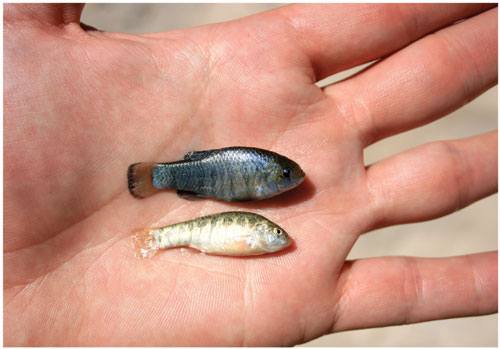
Photograph courtesy of Sean C. Lema.
As research on phenotypic plasticity accrues, it is becoming clear that almost all traits show some plasticity. My own studies on the physiological underpinnings of variation in body shape and behavior, however, are revealing something unexpected. Patterns of phenotypic variation among pupfish populations are generated in part through the plastic developmental responses of fish to their ecologically distinct habitats. This finding suggests that what we consider population- or species-specific phenotypes can be malleable and depend in part on the development of that population in the unique habitats where they live. And when the habitats change, species' phenotypic characteristics may quickly follow.
Death Valley may seem an unlikely place to find fish. Yet Death Valley and the Mojave Desert of the American Southwest harbor fish found nowhere else. Water is scarce in the desert, so the fishes that live there are rare also. However, it was not always this way. During the Pleistocene Epoch, Death Valley was filled by a lake that at one point stretched about 130 kilometers in length and was more than 180 meters deep. This was only the most recent in a series of precipitation-based, or pluvial, lakes created by climatic changes that left much of North America covered by glaciers and ice. Glaciers themselves never reached Death Valley, but the cooler climate of the Pleistocene produced a system of interconnected lakes and marshes, the remnants of which are scattered throughout the Mojave Desert today as dry lake beds.
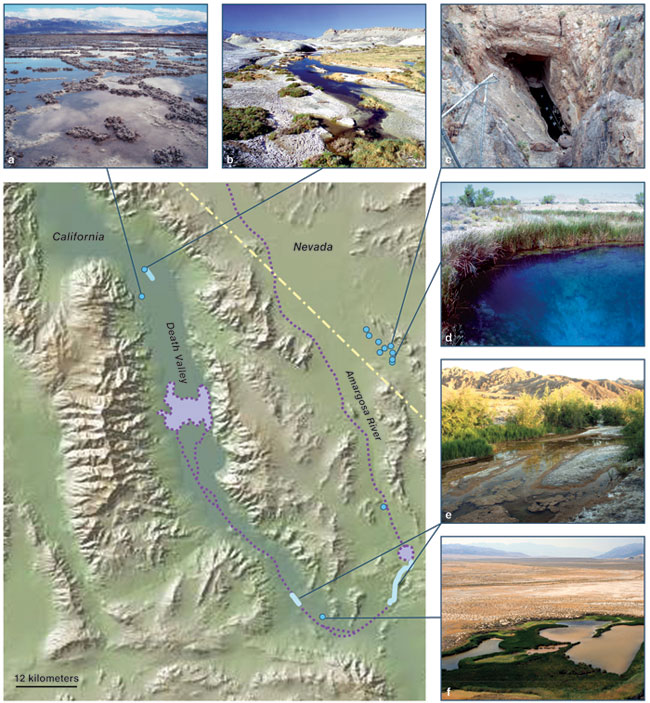
Photographs courtesy of Sean C. Lema. Map by Barbara Aulicino and Stephanie Freese.
Pupfish first entered the Death Valley region through a connection with the Colorado River during one of these milder climatic periods two million years ago. As the climate became increasingly arid over the past 8,000 to 10,000 years, however, the lakes of Death Valley dried. Today, the water supplying the valley's permanent aquatic habitats comes not from rain but from the underground aquifer. Water in this aquifer originated as precipitation during pluvial times and was retained underground for 10,000 years before emerging through seeps and springs.
Today, the aquatic habitats occupied by Death Valley's pupfishes are diverse and range from freshwater pools to saline marshes. Larger springs such as Big Spring in Ash Meadows National Wildlife Refuge, Nevada, are stable in size and have low salinity and constant temperature. Saratoga Springs consists of a similar large spring that nourishes a shallow marshland. Not all of these habitats are freshwater, however. Cottonball Marsh is so saline that little vegetation can grow.
Pupfish also occupy two desert streams, each of which fluctuates widely in temperature and extent. Salt Creek is a saline stream located on the floor of Death Valley and fed by a spring at its marshy headwaters. The Amargosa River is less saline, but its temperature can fluctuate more than 25 degrees Celsius between day and night. The Amargosa River is the largest pupfish habitat in the Death Valley region, stretching some 200 kilometers from headwaters to terminus on the valley's floor. Without a recent rainstorm, however, the river is dry over about 90 percent of its length. The Amargosa River is largely an underground watercourse. Water percolates beneath the sand over much of its length and flows to the surface only where bedrock forces the water upward.
Perhaps the most remarkable aquatic habitat in Death Valley, however, is Devil's Hole—a 14-meter-deep rock fissure that exposes a water-filled cavern plunging more than 133 meters into the groundwater aquifer. The aquatic environment of Devil's Hole is almost too warm and too low in food for pupfish to survive and reproduce. And yet, this fissure is the only natural habitat for one of the world's rarest vertebrates—the Devils Hole pupfish.
When I first began studying the behavior of Death Valley's pupfishes, it quickly became apparent that pupfish behavior is strongly dependent on the current physical and social conditions of their habitat. I observed that male pupfish in the Amargosa River are aggressive as they protect breeding territories during early spring. Yet during summer, males abandon these territories when desiccation and an abundance of young pupfish spawned that spring makes the density of fish too high to defend territories successfully. Instead, male pupfish reduce their aggression and spend more time courting females as part of mixed-sex schools.
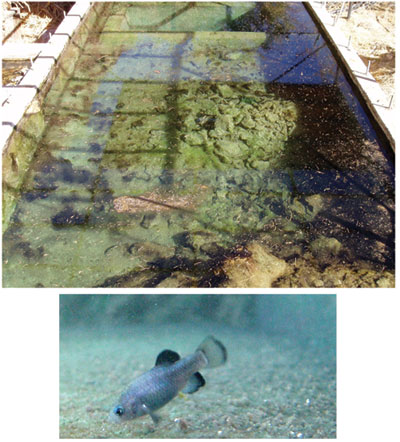
Top photograph courtesy of Abraham P. Karam. Bottom photograph courtesy of Lindsey T. Lyons.
It was clear to me from these early observations that if I wanted to understand how Death Valley's pupfishes are evolving in their distinct habitats, I needed to examine the phenotypic plasticity of pupfish and ask how plasticity itself varies among populations living in dissimilar habitats.
The environment that organisms experience during development has long been known to affect the phenotype that they express later in life. Since phenotypic variation caused by such plasticity is environmentally generated, for many years such variation was considered to be "non-genetic" and irrelevant to evolution. Recently, however, accumulating evidence has established that plasticity itself has a genetic basis. Although the phenotypes generated by plasticity are induced by the environment, the phenotypic responses are produced by changes in gene expression. Studies have demonstrated that the sensitivity of genes responding to the environment can vary among organisms with different genetic backgrounds. The picture that is emerging suggests that the degree of plasticity an individual shows is determined both by the environment that the individual experiences and by the genomic composition of that individual.
Now that plasticity is known to have a genetic basis, and is therefore heritable, the role of plasticity in the evolution of species is being reconsidered. Mary Jane West-Eberhard of the Smithsonian Tropical Research Institute has pointed to one scenario whereby plasticity may lead to evolutionary divergence:
The origin of a new direction of adaptive evolution starts with a population of variably responsive, developmentally plastic organisms. That is, before the advent of a novel trait, there is a population of individuals that are already variable, and differentially responsive, or capable of producing phenotypic variants under the influence of new inputs from the genome and the environment. Variability in responsiveness is due partly to genetic variation and partly to variations in the developmental plasticity of phenotype structure, physiology, and behavior that arise during development. . . .
If the environment changes, plasticity may cause a reorganization of phenotype, ultimately leading to the expression of new traits in the population. If individuals in the population vary in plasticity, any resulting phenotypic differences might produce dissimilarities in reproductive success or survival that, over time, lead to evolutionary change in the population.
But how might phenotypic plasticity play a role in the evolution of Death Valley's pupfishes? To answer this question, I needed to examine the proximate mechanisms of plasticity in pupfish and explore whether those mechanisms are evolving between populations isolated in ecologically dissimilar habitats. I began my own studies by focusing on the hormonal mechanisms of plasticity. As chemical messengers, hormones influence phenotypic development by regulating gene expression in response to changes in the environment. Broadly, hormones can be viewed as a developmental link between an organism's genes and its environment.
My research on the endocrine bases of plasticity in pupfish is following two paths. In one line of study, I am asking how habitat conditions influence the morphology, or body size and shape, of pupfish. I do this by examining how environment and hormones interact in regulating morphological plasticity. As a second avenue of research, I am examining the neuroendocrine basis for population differences in aggressive behaviors. Together, these studies are uncovering how the environment experienced during early life can be important for shaping patterns of morphological and behavioral diversity in the wild.
Devil's Hole is considered the most restricted natural habitat for any vertebrate species. Perhaps it is fitting then that the fish that lives here—the Devils Hole pupfish (Cyprinodon diabolis)—is also unique among pupfishes. Devils Hole pupfish are generally no more than 20 millimeters in length. The species has an unusual shape: a large head, large eyes, a shallow body depth and the absence of pelvic fins. This morphological distinctiveness, combined with their reliance on only a single habitat, led to a certain notoriety that made the Devils Hole pupfish an exemplar for endangered-species conservation.
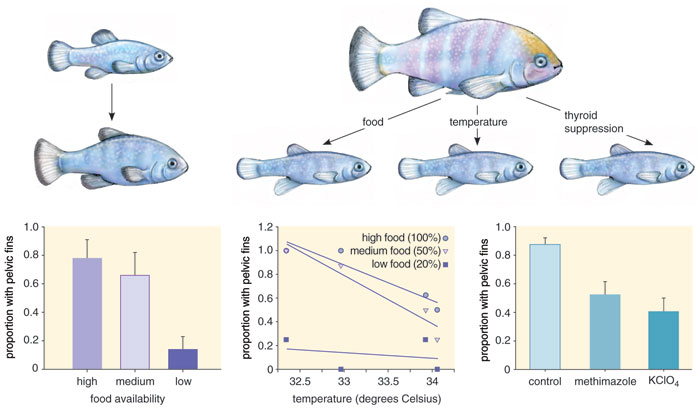
Stephanie Freese
During the late 1960s and early 1970s, groundwater pumping for agriculture was dropping the water level in Devil's Hole and threatening to expose a shallow rock shelf that is the main spawning habitat for the species. Concerned about the pupfish, a group of academics, government employees and private citizens met in 1969 to speak to the protections needed for fauna in Devil's Hole. This group became the Desert Fishes Council, an organization dedicated to this day to the study and preservation of desert aquatic ecosystems. Following a series of legal challenges, the U.S. Supreme Court ruled in 1976 in favor of the Devils Hole pupfish by deciding that protections for the endangered pupfish include the groundwater that supplies their only habitat.
Although the Court's decision halted groundwater pumping in the vicinity of Devil's Hole, it was clear that reliance on a single habitat made the Devils Hole pupfish vulnerable to extinction. Three refuges were therefore built to establish additional populations of the species. These refuges were constructed to simulate the environment of Devil's Hole, and new populations were established by transferring pupfish from Devil's Hole to the refuges. In 1977, however, only five years after their introduction, pupfish in one of the refuges were found to differ morphologically from the Devils Hole phenotype. Refuge pupfish were larger and more deeply bodied, and had smaller head sizes than fish from Devil's Hole. In 2000, Andrew P. Martin and Jennifer L. Wilcox of the University of Colorado at Boulder found that pupfish in the other two refuges had also deviated morphologically, with 32 percent and 48 percent of fish exceeding the maximum length of pupfish in Devil's Hole.
What caused Devils Hole pupfish in the refuges to change their body shape? One possible explanation is that refuge populations evolved rapidly after their founding. Comparisons of microsatellite DNA loci in fish from Devil's Hole and the refuges by Martin and Wilcox suggested that refuge populations may have experienced founder effects or genetic drift—random genetic changes resulting from the establishment and maintenance of small populations. However, these processes do not appear to explain why the morphology of pupfish in all three refuges diverged in similar ways. Alternatively, rapid morphological change may reflect plastic responses to the novel conditions in the refuges.
Gabrielle A. Nevitt, a colleague at the University of California, Davis, and I tested this plasticity hypothesis by examining how the morphology of pupfish responds to extreme conditions. Since the Devils Hole pupfish is rare, we chose to study a closely related species, the Amargosa River pupfish, as a surrogate. Work by James E. Deacon and Carol D. James of the University of Nevada, Las Vegas, established that pupfish in Devil's Hole grow unusually slowly at the high temperature (33 degrees) and with the limited food supply in their habitat. Could that slow growth affect how pupfish develop morphologically?
For our experiments, we reared newly hatched Amargosa River pupfish under conditions that mimic those in Devil's Hole by raising temperature and restricting food rations. These rearing conditions led fish in the experiment to grow at a rate comparable to pupfish in Devil's Hole. Examination of the pupfish four months later revealed that Amargosa River pupfish reared with a slow rate of growth developed a morphology similar to pupfish in Devil's Hole. Although this experiment did not recreate the Devils Hole morphology fully, the Amargosa River pupfish retained many features of their juvenile life stage—a large head, large eyes and the absence of pelvic fins—into later life. We also found that at temperatures near those found in Devil's Hole, even slight differences in rearing temperature affected how pupfish developed morphologically.
But what physiological mechanism underlies this plastic response of morphology? One possible explanation was provided from a study of zebrafish (Danio rerio) by Donald D. Brown of the Carnegie Institution in Washington, D.C. Brown exposed larval zebrafish to goitrogens that block the production of thyroid hormones from the thyroid gland. Zebrafish exposed to goitrogens developed without pelvic fins—a morphology resembling that of pupfish in Devil's Hole. Thyroid hormones mediate the transition from larval to juvenile morphology in fish. This transition is also the period of life when pelvic fins first develop. Building on these findings, we exposed newly hatched Amargosa pupfish to goitrogens and found that these fish again developed body characteristics similar to pupfish in Devil's Hole. Curious whether pupfish with slow growth showed altered thyroid status, we also measured levels of the thyroid hormone thyroxine (T4) in the pupfish from the food-restriction experiment described above. We found that pupfish from the lowest ration treatment had lower whole-body levels of T4, supporting the hypothesis that environmentally induced changes in thyroid status mediate morphological plasticity in pupfish.
If phenotypic plasticity is indeed responsible for the different body shapes of refuge pupfish, one would expect to see key environmental differences between the refuges and Devil's Hole. Such evidence was provided recently by Michael S. Parker and Abraham P. Karam from Southern Oregon University. They conducted a thorough environmental assessment of the habitats of Devils Hole pupfish and found that the refuges are slightly lower in temperature and higher in dissolved oxygen, and they have more abundant food than Devil's Hole. Each of these environmental factors can affect the metabolism, and therefore growth, of pupfish. Taken together, these findings suggest that the unique morphology of pupfish in Devil's Hole may be due in part to paedomorphosis, where juvenile traits are retained into adulthood. Environmentally induced retention of juvenile features is not commonly associated with fish but has been documented in other taxa including amphibians inhabiting cold, high-elevation lakes. Our experiments, however, suggest that the physiology and development of the Devils Hole pupfish changed in the novel conditions of the refuges, producing the observed changes in morphology.
Male pupfish are pugnacious. During the breeding season, males display, chase and nip as they establish and defend reproductive territories. As graduate students at the University of California, Los Angeles, during the 1960s, David L. Soltz and Richard Liu made detailed behavioral studies of Death Valley's pupfishes. Their work revealed that pupfish populations vary in behaviors including aggression and courtship. For instance, populations in large spring habitats such as Big Spring show territorial breeding where males are highly aggressive. Pupfish in Devil's Hole, in contrast, are not aggressive but court females intensely.
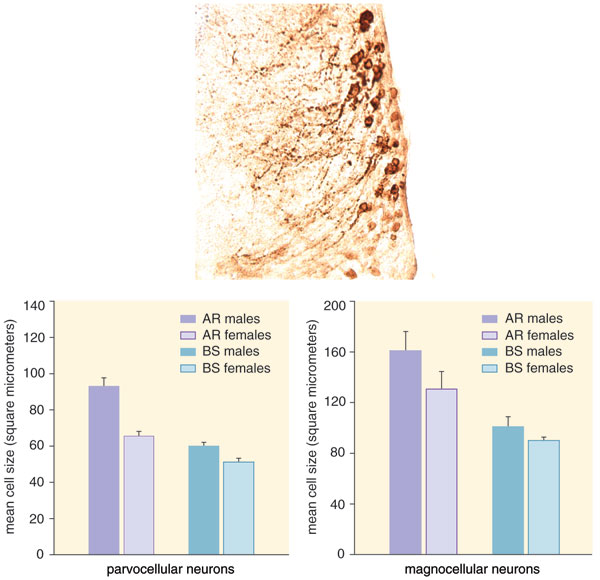
Image courtesy of Sean C. Lema. Graphs by Stephanie Freese.
As previously mentioned, however, the behavior of some populations varies seasonally. This variation results from shifts in pupfish reproductive activity in response to seasonal changes in water temperature and other environmental factors. Not all populations show similar behavioral changes, though. Pupfish in variable habitats such as the Amargosa River alter their aggression with seasonal variation in pupfish population density and water temperature, whereas fish in comparatively stable habitats such as Big Spring show territorial breeding year-round.
Given that behavior can vary so widely among populations, has the behavior of Death Valley's pupfishes evolved in response to their ecologically dissimilar habitats? And, if so, what proximate mechanisms might underlie that behavioral evolution? One possible mechanism came from studies on the bluehead wrasse (Thalassoma bifasciatum) by John Godwin and Katharine Semsar of North Carolina State University. The bluehead wrasse is a coral reef fish that changes sex from female to male in response to social cues. Besides changing sex, the wrasse also shifts between territorial and nonterritorial behaviors according to social conditions.
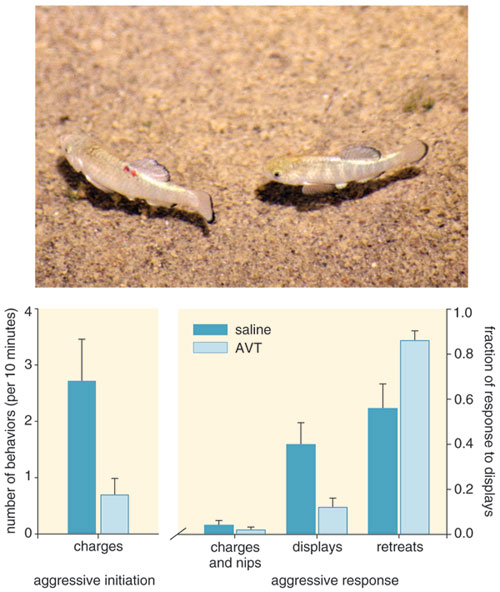
Photograph courtesy of Sean C. Lema. Graphs by Stephanie Freese.
Godwin and Semsar demonstrated that these shifts in territoriality are mediated by arginine vasotocin (AVT). AVT is a peptide hormone produced in the preoptic area of the hypothalamus. AVT is secreted into circulation to regulate hydromineral balance, but also acts as a neurotransmitter within the brain to modulate behavior. In the bluehead wrasse, the AVT system responds rapidly to social cues and underlies shifts in territorial behaviors. Could the AVT system play a similar role in regulating differences in territoriality and aggression among Death Valley's pupfishes?
To begin to answer this question, Nevitt and I explored whether pupfish populations in the wild differ in their neural AVT phenotype. We focused these studies on pupfish from two Death Valley habitats, the Amargosa River and Big Spring. These two populations have been isolated from each other for less than 4,000 years and provide an opportunity to examine the process of behavioral evolution as it is taking place. Using an antibody to AVT, we labeled and quantified AVT-synthesizing neurons in the brains of pupfish from these two Death Valley habitats. Males and females from the Amargosa River showed larger AVT neurons in two specific regions of the preoptic area of the hypothalamus—the parvocellular and magnocellular nuclei—relative to same-sex individuals from Big Spring.
Neurons in the parvocellular and magnocellular regions have been linked to the regulation of stress responses, hydromineral balance and social behavior in fish, so the differences in neural AVT phenotype that we found might be associated with variation in any of those functions. As a next step, we examined how AVT influences pupfish behavior by administering AVT to male Amargosa River pupfish under both controlled laboratory conditions and in their natural habitat. Under both testing conditions, exogenous AVT caused male pupfish to become less aggressive, demonstrating that AVT indeed regulates pupfish behavior.
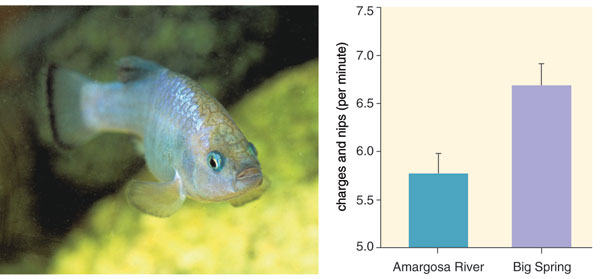
Photograph courtesy of Sean C. Lema. Graph by Stephanie Freese.
All the same, it remained unclear whether the AVT system had evolved between the populations. We found the answer to this question by breeding pupfish from the Amargosa River and Big Spring habitats in captivity. Offspring were reared under different conditions of salinity (0.4 parts per thousand or 3 parts per thousand) and temperature (stable or daily fluctuating) to represent the range of environmental variation experienced in the populations' two habitats. This experimental design permitted us to examine how salinity and temperature influenced the AVT system and behavior of pupfish, while also allowing comparison of how plasticity in the AVT system might differ between the Amargosa River and Big Spring populations.
Results from this experiment revealed that Big Spring pupfish are more aggressive than fish from the Amargosa River, providing evidence that these two pupfish populations have evolved differences in behavior. Big Spring pupfish show a highly territorial breeding system with little seasonal variation, and pupfish in this habitat have evolved higher aggression in response to these social challenges. The Big Spring and Amargosa River populations also evolved differences in how their AVT systems respond to salinity and temperature conditions. These evolutionary changes, however, vary among different AVT-producing neuron groups in the brain. Parvocellular AVT neurons, which appear to mediate physiological responses to stressors, showed plastic changes to temperature in Big Spring pupfish but not Amargosa River pupfish. The populations also differed in how the parvocellular neurons responded to salinity. Magnocellular AVT neurons, in contrast, show plastic responses to salinity and temperature, but this plasticity is similar in both populations.
So far, these studies have established that phenotypic plasticity can contribute to population-level variation in the neural pathways underlying aggression and that plasticity in brain pathways can evolve in as little as 4,000 years. Nevertheless, we are only beginning to unravel the role that phenotypic plasticity and the AVT system play in behavioral diversification of Death Valley's pupfishes.
Taken together, these studies of phenotypic plasticity are revealing new insights into how phenotypic differentiation is occurring among Death Valley's pupfishes. This work has uncovered how the environment experienced during development plays an underappreciated role in generating phenotypic variation in the wild. Our findings suggest that population- or species-specific phenotypes can result not only from a population's genomic background but also from the interaction of individuals with that population's unique environment.

Stephanie Freese
Recently, the importance of understanding the plasticity of pupfish has taken on a new urgency. The population in Devil's Hole has been declining gradually since the early 1990s for reasons that remain unclear. In 2003, one of the refuge populations was exterminated, and a second has since hybridized with another species of pupfish. A census in April 2006 revealed only 38 adult pupfish remaining in Devil's Hole. New conservation efforts, including the breeding of Devils Hole pupfish in captivity, are now being undertaken. As the Devils Hole pupfish example illustrates, however, the future of Death Valley's pupfishes remains uncertain. Pupfish in Death Valley, as well as fishes through the desert Southwest, continue to be threatened by new introductions of non-native species and unremitting calls for pumping of the aquifers that nourish their aquatic habitats. How Death Valley's pupfishes will fare in the face of these challenges remains to be seen.
In the meantime, research on pupfish is raising some important questions about the goals of conservation. If the phenotypes of animals can be intimately tied to their environments, what are we trying to preserve—the unique genetic composition of the animal or the unique animal in the context of its distinctive environment? Is it the same species if it is not preserved in the habitat that made it unique?
As awareness grows that phenotypic plasticity can shape the traits of imperiled species, new approaches are surfacing that use knowledge of a species' plasticity to achieve conservation goals. For instance, it has been suggested that managing habitats to generate a specific range of phenotypic variation could be useful for increasing the likelihood that a population or species will persist over the long-term. Such a "phenotype management" approach is based on recognition that the scope of phenotypic variation in a population is linked to the range of environmental variation experienced by members of that population during their lives.
In the case of pupfish, studies of how the environment influences phenotypic development are leading to new insights about how these fish respond to environmental change. Although more research is needed to fully understand how phenotypic plasticity has affected evolution of the pupfish that call Death Valley home, these studies have already revealed that when it comes to understanding the origins of variation in morphology, behavior and the brain, it's not only who you are but where you live.
The author thanks Gabrielle Nevitt, Penny Swanson and Thomas Hahn for their advice and encouragement throughout this research. Gratitude is also extended to James Deacon, Phil Pister and all members of the Desert Fishes Council for their unremitting efforts to preserve the unique native fishes of North America's deserts. The author also thanks Sarah Hamilton for assistance with fish care, and Jennifer DeBose for suggestions that greatly improved this manuscript.
Click "American Scientist" to access home page
American Scientist Comments and Discussion
To discuss our articles or comment on them, please share them and tag American Scientist on social media platforms. Here are links to our profiles on Twitter, Facebook, and LinkedIn.
If we re-share your post, we will moderate comments/discussion following our comments policy.